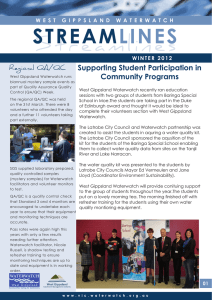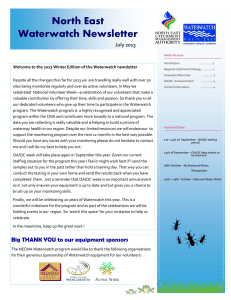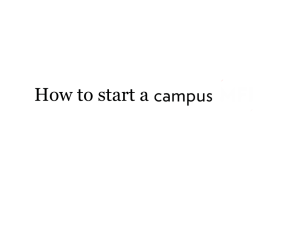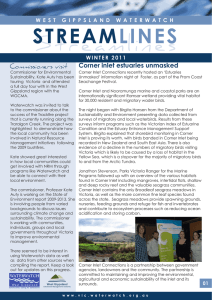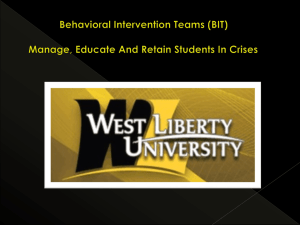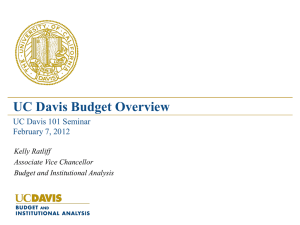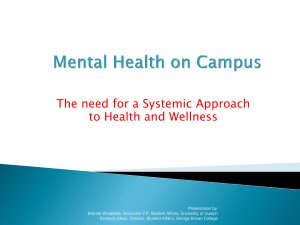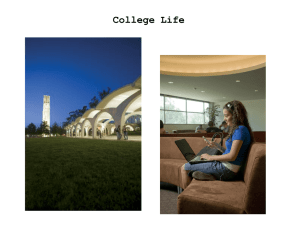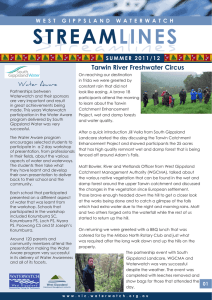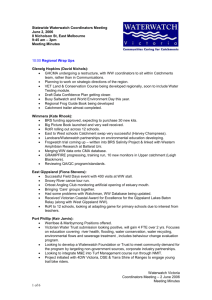WATERWATCH FOUNDATION From weather report to growth
advertisement
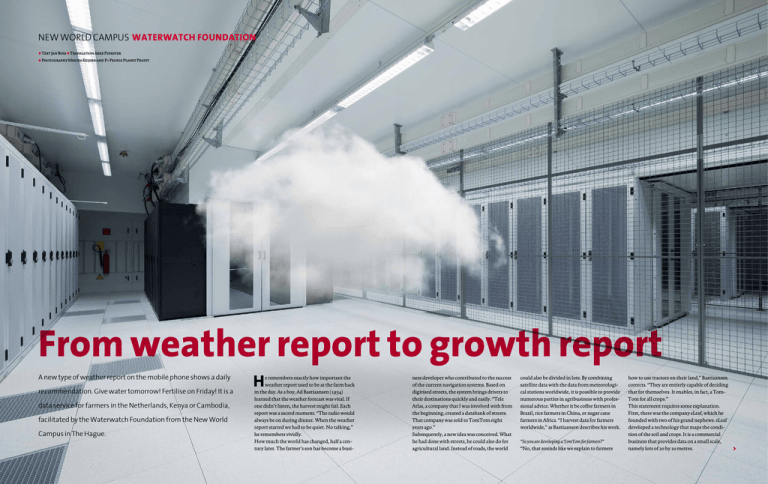
NEW WORLD CAMPUS WATERWATCH FOUNDATION + Text Jan Bom + Translation Akke Pinkster + Photography Mischa Keijser and P+ People Planet Profit P+ december + januari + februari 2014/2015 31 P+ december + januari + februari 2014/2015 30 From weather report to growth report A new type of weather report on the mobile phone shows a daily recommendation. Give water tomorrow! Fertilise on Friday! It is a data service for farmers in the Netherlands, Kenya or Cambodia, facilitated by the Waterwatch Foundation from the New World Campus in The Hague. H e remembers exactly how important the weather report used to be at the farm back in the day. As a boy, Ad Bastiaansen (1954) learned that the weather forecast was vital. If one didn’t listen, the harvest might fail. Each report was a sacred moment. “The radio would always be on during dinner. When the weather report started we had to be quiet. No talking,” he remembers vividly. How much the world has changed, half a century later. The farmer’s son has become a busi- ness developer who contributed to the success of the current navigation systems. Based on digitised streets, the system brings drivers to their destinations quickly and easily. “Tele Atlas, a company that I was involved with from the beginning, created a databank of streets. That company was sold to TomTom eight years ago.” Subsequently, a new idea was conceived. What he had done with streets, he could also do for agricultural land. Instead of roads, the world could also be divided in lots. By combining satellite data with the data from meteorological stations worldwide, it is possible to provide numerous parties in agribusiness with professional advice. Whether it be coffee farmers in Brazil, rice farmers in China, or sugar cane farmers in Africa. “I harvest data for farmers worldwide,” as Bastiaansen describes his work. “So you are developing a TomTom for farmers?” “No, that sounds like we explain to farmers how to use tractors on their land,” Bastiaansen corrects. “They are entirely capable of deciding that for themselves. It enables, in fact, a TomTom for all crops.” This statement requires some explanation. First, there was the company eLeaf, which he founded with two of his grand nephews. eLeaf developed a technology that maps the condition of the soil and crops. It is a commercial business that provides data on a small scale, namely lots of 20 by 20 metres. > “The New World Campus will function like an ecosystem” > Bastiaansen: “To illustrate, we receive requests from people who are looking to buy a piece of land. Questions include: can you check what happened to this lot over the last decade? Has it been neglected? How many tonnes of potatoes did it produce?” The Waterwatch Foundation, which was established in 2011, works on a much larger scale with lots of 250 by 250 metres. The ambitions are also much greater: resolving global issues related to food security and efficient use of water. “We are establishing a new global standard,” Bastiaansen explains. “It is a worldwide uniform database that enables us to link, analyse and compare data on water and food security on a global scale.” It is important to establish a global standard in this field. Bastiaansen: “The offer of databases in the world is still very fragmented. The Waterwatch Foundation creates a single database: the Global Vegetation Database 3.0. The database is available to parties all over the world, e.g. NGOs in Brazil and farmers in Kenya. Stakeholders in food production can use it to exchange and compare data and share best practices . This is impossible with the current patchwork of miscellaneous datasets. A unique aspect is that the database is widely 33 accessible, easy to use and completely free of charge. Moreover, it is a quantitative database. It can indicate exact amounts in, say, kilos, litres or degrees. This makes us one-of-a-kind; all other current data are index data, which cannot be used to develop software applications. Ours can.” “So, will a satellite eventually be able to measure the fertility of the soil?” Bastiaansen: “That isn’t necessary. The satellite sees the crop grow, a few weeks after it breaks ground. The leaf indicates the type of crop and its condition. It shows which crop does well on which type of soil.” Bastiaansen looks to his side. Beside him is Harry Derksen (1955). Together with Jack van Ham he is the founding father of the New World Campus in The Hague, where the Waterwatch Foundation will reside. The two share the same ambition: resolving global issues. For the Waterwatch Foundation it involves global issues related to food security and the efficient use of water. In 2050, the earth will be home to nine billion people; two billion more than there are now. This means that more food has to be produced in the short term, but with What does the technology of the Waterwatch Foundation involve? The Waterwatch Foundation does not supply satellite images, but data based on a unique technology in which data from satellites is analysed and then mapped in areas of 250x250 metres. This new global standard for crops is based on unique analysis and calculation technologies from current satellite and meteorological data, among others. The Waterwatch Foundation provides the data to application developers in combination with a Software Development Kit and Application Protocol Interface (to make it easy to use). These developers can then create a ‘TomTom for crops’. By supplying the required information for free, the Foundation helps improve agricultural production in a sustainable way. the same amount of water. The vegetation database will contribute to making this possible. Moreover, these types of issues are interdisciplinary. It requires a multitude of parties; from investors and companies to knowledge institutes and civil society organisations with knowledge of local conditions. Normally it is difficult to bring these parties together, but, as of next year, many of them will be working together at the New World Campus. “For us this is an important reason to reside there,” says Bastiaansen. On his laptop Derksen shows a satellite image from a presentation by the Waterwatch Foundation. “Here we see the border between India and Pakistan. We are talking about the same region, the same crop (rice, in this case), and the same climate. Everything is the same. And yet, more biomass grows in India than in Pakistan. The difference is so large that the national borders can be seen from space. How is that possible? It means that the government of India uses different regulations than the government of Pakistan. In India they have a water quota, in Pakistan they don’t. And although India is more economical with its water usage, they still produce a higher yield. In the one country the farmers think: it’ll be dry tomorrow, I’ll give them some extra water. And sometimes it is just too much. The word ‘too’ is not a good thing in this regard: crops don’t benefit from too much water. Too much nitrogen also hampers growth. It is important to take the right action at the right time. This results in yield improvements, and eventually in more ‘crop per drop’.” There are several reasons why the Waterwatch Foundation is a unique partner to Derksen. In addition to the focus areas sanitation, sustainable construction, ICT and energy, the Campus also focuses on issues related to food and water. Bastiaansen wants to help the entire world, but to do so he needs the help of many other parties. The New World Campus hosts a multitude of parties both online and at the Campus location At the New World Campus Harry Derksen (left) connects companies, NGOs, investors, knowledge institutions and local governments to Ad Bastiaansen (right) of the Waterwatch Foundation, who provides stakeholders in food processing worldwide with a free up-to-date database for crops. in The Hague. This includes small and medium enterprises, investors, NGOs, knowledge institutions and even part of the Dutch government will be represented here. Derksen says: “The Campus functions in this respect as an ecosystem, providing a breeding ground for innovation in the field of sustainable international business. It will offer its residents a platform for sharing knowledge and ideas, contributing thereby to solutions for global problems.” Bastiaansen gives an example. “There is also the issue of insurance. Drought causes damage to crops - this is true for the whole world - but there is no such thing as drought insurance. There is hail insurance, but that is a rare occurrence. And there is storm insurance, which is also rare. Hail and storm can be measured, but how can one measure drought? Well, our technique allows us to do just that. Because we take weekly measurements we can indicate water stress. There are two causes. Of course, there is always Mother Nature. No rainfall. Then there are farmers who forget to water the crops in time, and farmers who can only passively look on because they don’t have access to water. In the first case it involves mismanagement, because water is not given when needed. In the second case farmers could lay claim to an insurance product.” Derksen suggests: “At the New World Campus parties can work together on novel ideas and solutions which will be developed into viable business cases. Cooperation between the various parties can result in a type of public-private partnerships, and we will be there to support the process.” “And there will be events on the Campus that will bring all parties together?” Derksen: “The campus will host events, conferences and seminars on themes that are relevant for the New World Campus community. The campus provides a platform where they can present their work and share their experiences. When these presentations lead to questions the residents can easily knock on someone’s door or strike up a casual conversation at the coffee corner. We can also discuss global issues within the entire community in the so-called Wicked Problems Plaza. Imagine a type of arena, a place where tricky bottlenecks can be resolved and revolutionary solutions can be found.” Bastiaansen sees another opportunity to bring parties together. His Foundation does not just focus on the areas of agribusiness and water, but also has a third spearhead. Firing away like he is the life and soul of the Wicked Problems Plaza presenting a pitch to stimulate other parties, he says: “The Waterwatch Foundation can facilitate parties that aim to contribute to a larger intake of CO2. We can measure the biomass to a very exact degree. Everyone talks about the emissions of greenhouse gases, but at some point input can be a much more interesting subject to sustainably operating businesses. Why would a company only invest in eliminating those last few milligrams? With the same funds, it may be able to develop entirely new agricultural areas that take in more CO2 than they would be able to save by themselves. The Waterwatch Foundation can can measure the increase of CO2 intake for any arable piece of land on earth by using satellite based data. This could potentially benefit the entire planet.” www.waterwatchfoundation.com www.newworldcampus.com The New World Campus will open early 2015 at the Spaarneplein 2 in The Hague. P+ december + januari + februari 2014/2015 P+ december + januari + februari 2014/2015 32 “I harvest data for farmers worldwide”
